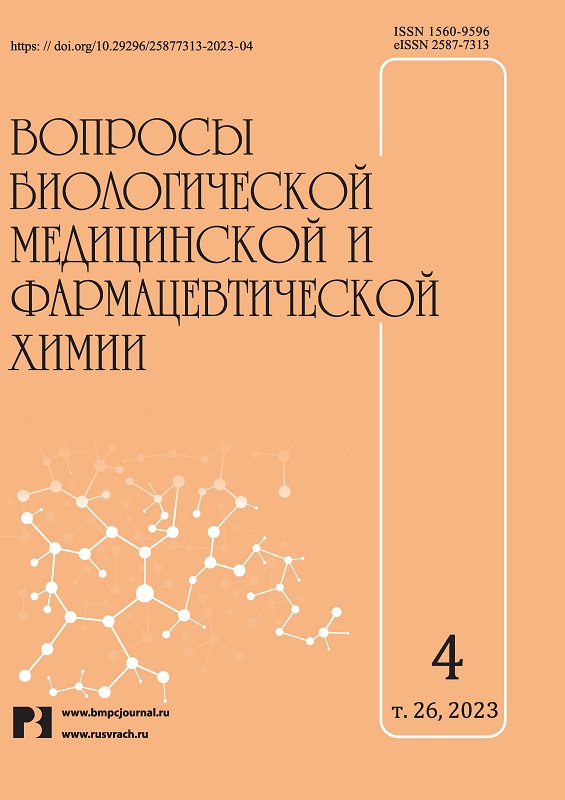Development and validation of HPLC-MS/MS method for molsidomine quantitation in various tissues of rats
- 作者: Popov N.S.1, Balabanyan V.Y.2, Baranov N.S.3
-
隶属关系:
- Tver State Medical University
- M.V. Lomonosov Moscow State University
- Shemyakin-Ovchinnikov Institute of Bioorganic Chemistry of the Russian Academy of Sciences
- 期: 卷 26, 编号 4 (2023)
- 页面: 32-42
- 栏目: Pharmaceutical chemistry
- URL: https://journals.eco-vector.com/1560-9596/article/view/340940
- DOI: https://doi.org/10.29296/25877313-2023-04-06
- ID: 340940
如何引用文章
详细
Relevance. Molsidomine is a vasoactive drug from the group of sydnonymines widely used in clinical practice. The use of molsidomine as a comparison drug during pharmacokinetic studies of new pharmacological agents of the sidnonymine group requires the development and implementation of accurate and reproducible methods for the quantitative determination of this drug in the organs and tissues of experimental animals.
Purpose of the study. Development and validation of a method for quantitative determination of molsidomine in various rat tissues using HPLC-MS/MS.
Materials and methods. Quantitative determination of molsidomine in blood plasma and homogenates of rat tissues was carried out by high-performance liquid chromatography with mass spectrometric detection. Method of precipitation of proteins with methanol was applied as a sample preparation of biological material. An Agilent Infinity LabPoroshell 120 EC-C18 4.6x100 mm 2.7 Micron column was used for chromatographic separation using an aqueous solution of methanol.
Results. The developed bioanalytical method was validated according to the following parameters: selectivity, matrix effect, sample transfer, linearity of the analytical range, lower limit of quantitative determination (NPCO), intra- and inter-series accuracy and precision, dilution factor, stability of the studied substances at the stages of analysis.
Conclusion. A method of quantitative determination of molsidomine in blood plasma and homogenates of rat tissues has been developed and validated. The analytical range for blood plasma, liver, kidney, brain and spleen homogenates was 5.0–1000.0 ng/ml; for skeletal muscle and heart tissue homogenates was 1.0-1000.0 ng/ml; for adipose tissue homogenate was 10.0–1000.0 ng/ml. This study allows us to use the developed methodology for conducting the analytical part of pharmacokinetic studies of molsidomine.
全文:
作者简介
N. Popov
Tver State Medical University
编辑信件的主要联系方式.
Email: ns.popov@mail.ru
ORCID iD: 0000-0002-1792-7414
Ph.D. (Pharm.), Head of Research Laboratory, Associate Professor, Department of Pharmacology and Clinical Pharmacology
俄罗斯联邦, TverV. Balabanyan
M.V. Lomonosov Moscow State University
Email: ns.popov@mail.ru
ORCID iD: 0000-0002-5744-7060
Dr.Sc. (Pharm.), Associate Professor, Leading Research Scientist, Laboratory of Translational Medicine
俄罗斯联邦, MoscowN. Baranov
Shemyakin-Ovchinnikov Institute of Bioorganic Chemistry of the Russian Academy of Sciences
Email: ns.popov@mail.ru
ORCID iD: 0000-0002-9339-7603
Ph.D. (Chem.)
俄罗斯联邦, Moscow参考
- Horton A., Schiefer I.T. Pharmacokinetics and pharmacodynamics of nitric oxide mimetic agents. Nitric Oxide. 2019; 84: 69–78. DOI: org/10.1016/j.niox.2019.01.001.
- Paes de Barros M., Casares Araujo-Chaves J., Marlise Mendes Brito A., Lourenço Nantes-Cardoso I. Oxidative/nitrative me-chanism of molsidomine mitotoxicity assayed by the cytochro-me c reaction with SIN-1 in models of biological membranes. Chemical Research in Toxicology. 2020; 33(11): 2775–2784. DOI: org/10.1021/acs.chemrestox.0c00122.
- Chistik T.V. Donatory oksida azota v terapii pacientov s ishemicheskoj bolezn'ju serdca: fokus na molsidomin. Arterial'naja gipertenzija. 2018; 2 (58). DOI:org/10.22141/2224-1485.2.58.2018.131062.
- Kosarev V.V., Babanov S.A. Sovremennye podhody k antianginal'noj terapii pri ishemicheskoj bolezni serdca: v fokuse sidnoniminy. Russkij medicinskij zhurnal. 2011; 14: 895–901.
- Hernández-Melesio M.A., Alcaraz-Zubeldia M., Jiménez-Capdeville M.E., Martínez-Lazcano J.C., Santoyo-Pérez M.E., Quevedo-Corona L., Pérez-Severiano F. Nitric oxide donor molsidomine promotes retrieval of object recognition memory in a model of cognitive deficit induced by 192 IgG-saporin. Behavioural brain research. 2019; 366: 108–117. DOI: org/10.1016/j.bbr.2019.03.031.
- Nikonov V.V., Kinoshenko E.I., Kursov S.V. Nitraty v klinicheskoj praktike. Medicina neotlozhnyh sostojanij. 2020; 16(4). DOI: org/10.22141/2224-0586.16.4.2020.207928.
- Messin R., Opolski G., Fenyvesi T., Carreer-Bruhwyler F., Dubois C., Famaey J. P., Géczy J. Efficacy and safety of molsidomine once-a-day in patients with stable an-gina pectoris. International journal of cardiology. 2005; 98(1): 79–89. DOI: org/10.1016/j.ijcard.2004.01.007.
- Mironov A.N. Rukovodstvo po jekspertize lekarstvennyh sredstv. T. II. M.: Grif i K. 2013: 280.
- Food and Drug Administration. Available at: https://www. fda.gov/regulatory-information/search-fda-guidance-documents/ bioanalytical-method-validation-guidance-industry.
- European Medicines Agency. Available at: https://www.ema. europa.eu/en/bioanalytical-method-validation.
- Slatter J.G., Stalker D.J., Feenstra K.L., Welshman I.R., Bruss J.B., Sams J.P., Shobe E.M. Pharmacokinetics, metabolism, and excretion of linezolid following an oral dose of [14C] linezolid to healthy human subjects. Drug Metabolism and Disposition. 2001; 29(8): 1136–1145.
- Dutot C., Moreau J., Cordonnier P., Spreux-Varoquaux O., Klein C., Ostrowski J., Pays M. Determination of the active metabolite of molsidomine in human plasma by reversed-phase high-performance liquid chromatography. Journal of Chroma-tography B: Biomedical Sciences and Applications. 1990; 528: 435–446. DOI: org/10.1016/S0378-4347(00)82401-9.
- Richter L. H., Jacobs C. M., Mahfoud F., Kindermann I., Böhm M., Meyer M. R. Development and application of a LC-HRMS/MS method for analyzing antihypertensive drugs in oral fluid for monitoring drug adherence. Analytica chimica acta. 2019; 1070: 69–79. DOI: org/10.1016/j.aca.2019.04.026.
补充文件











